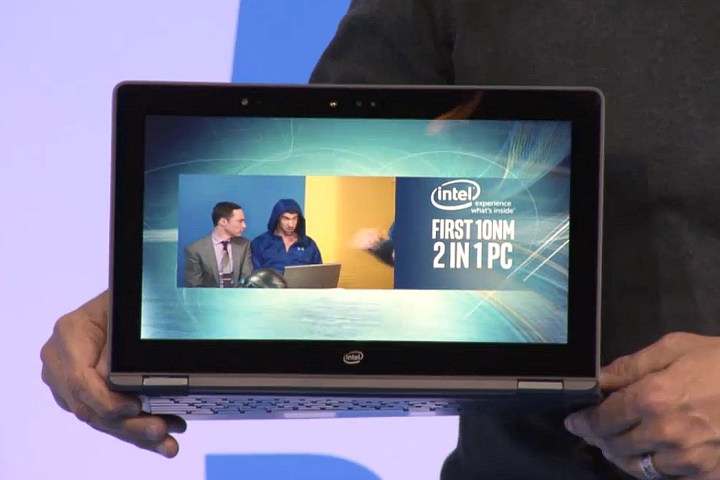
The reveal was made after Krzanich began talking about the new technology that is driving new experiences beyond the classic consumer electronic device. He said that powering all this innovation is Moore’s Law, which states that the transistors in a dense integrated circuit will double every two years. That pace actually slowed in 2012 with the introduction of 22nm process technology, pushing Krzanich to confirm that Intel’s progression slowed to 2.5 years.
For the last several years there has been a lot of talk about the death of Moore’s Law — that transistors will only get so small. However, Krzanich said that Moore’s Law is not dead and that Intel’s Cannon Lake processor design is a perfect example. “Moore’s Law is alive and well and flourishing,” he added.
The Cannon Lake device was a 2-in-1 PC sporting a screen that could bend back into a “theater” mode where the device sits on its connected keyboard and the screen stands upright. It was displaying a commercial on the screen along with a banner stating that the device in-hand is the first to sport a 10nm processor from Intel.
“So for those who are wondering if Moore’s Law is alive, is 10 nanometers going to be here, the answer is absolutely yes,” he said. “And I believe Moore’s Law will be well beyond my career — alive and well and kicking.”
Processors and products based on Intel’s Cannon Lake design are expected to ship before the end of 2017. Unfortunately, that is all Krzanich provided in regards to the 2-in-1 device and the embedded 10nm processor. However, he indicated that 10nm process technology will help evolve the current virtual reality market thanks to slimmer devices, better power efficiency, and better computing performance.
Krzanich’s brief Cannon Lake tease seemingly confirmed a recently leaked roadmap showing Cannon Lake to arrive in late 2017. As previously reported, Cannon Lake will be based on Intel’s first-generation 10nm process technology. The chips will fall into Intel’s ‘U’ and ‘Y’ processor lineup packing two cores and GT2 graphics. The U variants will have a total power draw of 15 watts whereas the Y variants will only have a 5.2-watt maximum.
According to the leaked slides, the Cannon Lake rollout will extend far into 2018 along with Intel’s Kaby Lake-U and Kaby Lake-H processors. The second quarter of 2018 is expected to produce Coffee Lake-H and Coffee Lake-U processors as well. The “H” variants will have six cores, GT2 graphics, and a power limit of 45 watts whereas the “U” variants will have four cores, GT3e graphics, and power envelopes of 15 watts and 28 watts.
As previously stated, this was the first time Intel revealed a device with a processor based on its 10nm process technology. Unfortunately, we saw absolutely nothing in regard to performance or energy efficiency. Perhaps we will see additional teases throughout the show and within the next several months so we aren’t yacking about leaked slides and rumors.
Editors' Recommendations
- Why the latest ThinkPad X1 Yoga Gen 8 isn’t worth the upgrade
- Despite Alder Lake launch, Intel isn’t ditching DDR4 yet
- Why Intel teased three products at CES 2020, but didn’t really announce any
- Ice Lake benchmarks show Intel isn’t done firing back at AMD
- Intel’s 10nm desktop dreams may be dead — new road map pushes them beyond 2022


